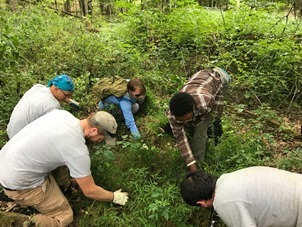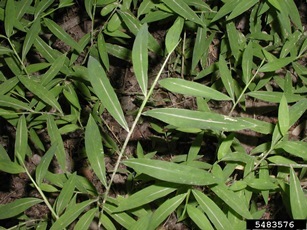|
Sept. 1, 2017
Contact: Greg Norwood, 517-342-4514 or Joanne Foreman, 517-284-5814
Invasive Japanese stiltgrass found near Ann Arbor
Be on the lookout for this new invader
 The Michigan Department of Natural Resources today announced that Japanese stiltgrass (Microstegium vimineum), an invasive plant originating in Asia, recently has been positively identified on private property in Scio Township, near Ann Arbor in Washtenaw County. This identification, confirmed by the University of Michigan Herbarium, is the first detection of this species in Michigan. The Michigan Department of Natural Resources today announced that Japanese stiltgrass (Microstegium vimineum), an invasive plant originating in Asia, recently has been positively identified on private property in Scio Township, near Ann Arbor in Washtenaw County. This identification, confirmed by the University of Michigan Herbarium, is the first detection of this species in Michigan.
Japanese stiltgrass has been on Michigan’s invasive species watch list since 2015 due to the grass’s presence in nearby states including Indiana, Illinois and Ohio. The species is believed to have arrived in the U.S. from Asia in the early 20th century, when it was used as a packing material for fine china. It is now widely distributed along the East Coast and in southern states.
Why be concerned?
“This annual grass is considered highly invasive, taking hold in areas of disturbed soil along banks, roadways and woods,” said Greg Norwood, invasive species coordinator for the DNR’s Wildlife Division. “Seeds can be transported by water or on animals, and seeds can remain viable in the soil for three to five years. Because deer don’t feed on Japanese stiltgrass, it often takes over in areas where deer browse on native plants and leave open patches of soil.”
What is being done?
The DNR is collaborating with The Stewardship Network, a nonprofit conservation group based in Ann Arbor, and other partners to identify the extent of the infestation. To date, small “satellite” populations have been located on the original property and a nearby site. The primary infestation was treated with herbicide, and plant material was burned. The small patches of grass at the satellite locations were removed by hand and disposed of.
How can you help?
The DNR is asking landowners, land managers and anyone spending time in the outdoors to be on the lookout for Japanese stiltgrass and to report the location and photos of any suspected findings to Greg Norwood at norwoodg@michigan.gov.
 Japanese stiltgrass looks like some native grasses, so it may not appear out of the ordinary to the general observer. Here is what to look for: Japanese stiltgrass looks like some native grasses, so it may not appear out of the ordinary to the general observer. Here is what to look for:
- A thin, bamboo-like grass with jointed stems and well-spaced leaves.
- Smooth green leaves 2 to 3 inches long and one-half inch wide, tapering to points at both ends, often with an off-center silver stripe or mid-rib.
- 1- to 3-foot-high beds of grass, with some stems running across the ground and others shooting upright.
- Roots, both at the base and stem joints, that are weakly attached to the soil and easy to pull up.
- One to three slender, green flower spikes at the stem tips, appearing in August or September.
Look-alike species
There are a few common plants in Michigan that easily may be mistaken for Japanese stiltgrass. These include:
- Smartweeds (Polygonum spp.), with tiny, white to pink flowers on a short spike and a tell-tale dark blotch near the center of each leaf.
- Whitegrass (Leersia virginica), which is well-rooted in the soil and has longer, thinner leaves than stiltgrass, with no mid-rib stripe.
- Northern shorthusk (Brachyelytrum aristosum), with fine hairs on the top, bottom and edges of its leaves and stems, and leaf veins in a pattern resembling an irregular brick wall.
More information about invasive species, including identification information for Japanese stiltgrass, can be found at www.michigan.gov/invasivespecies.
/Note to editors: Accompanying photos are available below for download. Suggested caption information follows.
Northern_shorthusk.jpg: A close-up of a northern shorthusk leaf reveals its unusual, brick-like leaf vein pattern. Photo courtesy Fontenelle Nature Association.
White_grass.jpg: Whitegrass looks similar to Japanese stiltgrass but has longer, thinner leaves and no mid-rib stripe. Photo courtesy Chris Evans, University of Illinois, Bugwood.org.
Stiltgrass_rapid_response.jpg: Volunteers hand-remove a small patch of Japanese stiltgrass near the primary infestation in Scio Township, Washtenaw County. Photo courtesy Michigan DNR.
Stiltgrass_primary.jpg: The primary infestation of Japanese stiltgrass in Scio Township, Washtenaw County, consisted of approximately 1,500 square feet of dense growth in a partially shaded area. Photo courtesy Andrea Matthies.
Stiltgrass_close-up.jpg: Japanese stiltgrass’s leaves come to a point at both ends and often have a silvery stripe or mid-rib near the middle. Photo courtesy Leslie J. Mehrhoff, University of Connecticut, Bugwood.org.
Pennsylvania_smartweed.jpg: Smartweeds have jointed stems and pointed leaves like stiltgrass, but they have white or pink flowers and leaves usually have a dark blotch across the center. Photo courtesy Michigan State University./
The Michigan Department of Natural Resources is committed to the conservation, protection, management, use and enjoyment of the state’s natural and cultural resources for current and future generations. For more information, go to www.michigan.gov/dnr.
|

 The Michigan Department of Natural Resources today announced that Japanese stiltgrass (Microstegium vimineum), an invasive plant originating in Asia, recently has been positively identified on private property in Scio Township, near Ann Arbor in Washtenaw County. This identification, confirmed by the University of Michigan Herbarium, is the first detection of this species in Michigan.
The Michigan Department of Natural Resources today announced that Japanese stiltgrass (Microstegium vimineum), an invasive plant originating in Asia, recently has been positively identified on private property in Scio Township, near Ann Arbor in Washtenaw County. This identification, confirmed by the University of Michigan Herbarium, is the first detection of this species in Michigan. Japanese stiltgrass looks like some native grasses, so it may not appear out of the ordinary to the general observer. Here is what to look for:
Japanese stiltgrass looks like some native grasses, so it may not appear out of the ordinary to the general observer. Here is what to look for: 




